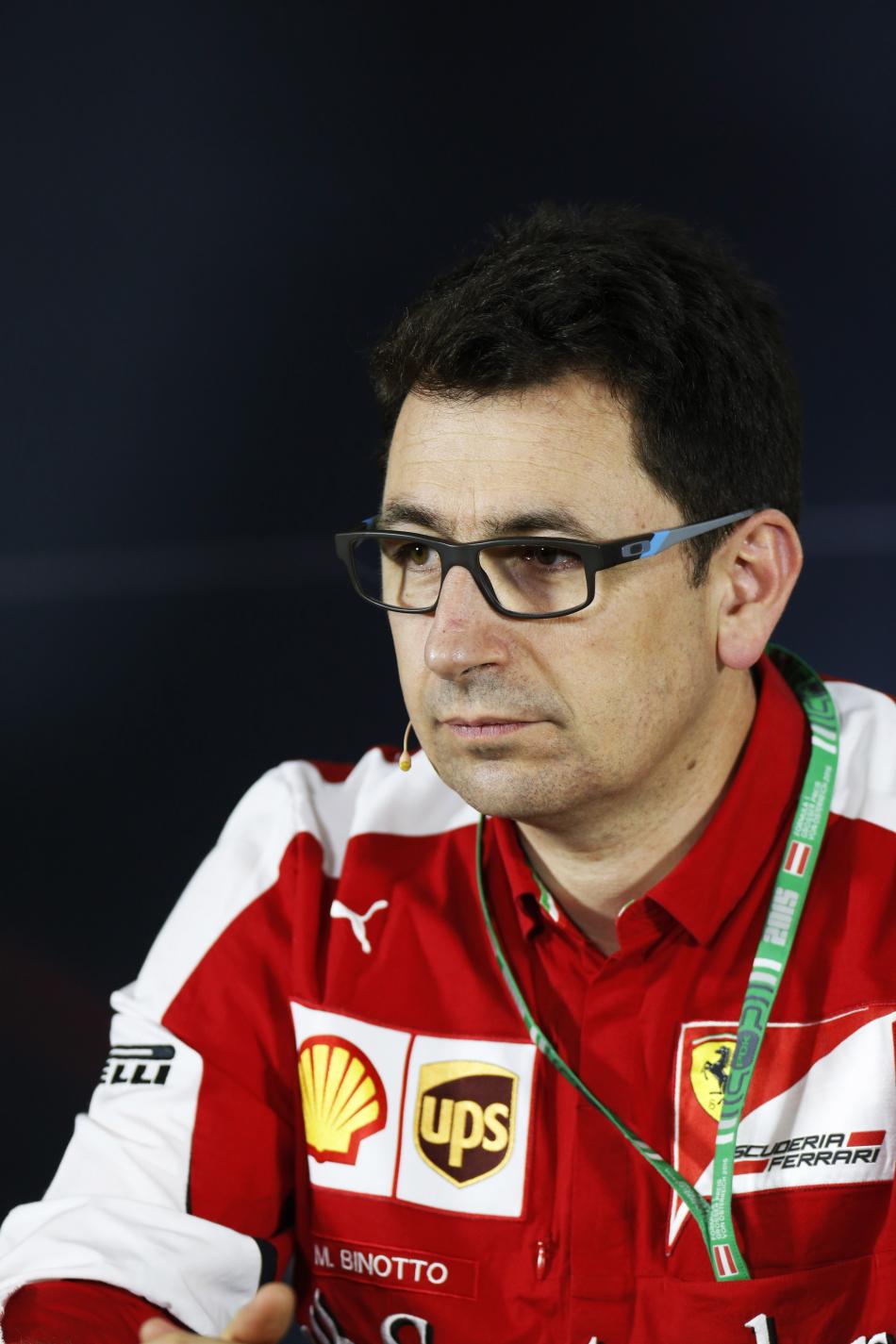F1 - M.Binotto: "We may be surprised later on in the season"
Transcript of the part two of the Friday Press Conference organised by the FIA for the 2017 Bahrain Grand Prix

PART TWO: TEAM PERSONNEL – Mattia BINOTTO (Ferrari), James ALLISON (Mercedes), James KEY (Toro Rosso)
PRESS CONFERENCE
Q: Mattia, a lot of new parts on the car this weekend. How have they performed and can you give us an explanation of the stoppages for Räikkönen and also for Vettel?
Mattia BINOTTO: It’s true, we’ve got a few new parts on the car this weekend. The most obvious was the front wing. To see how if they are behaving well or not, we need some more analysis. So far, so good but let’s see when the engineers have looked at all the data what we run for the rest of the weekend. On the problems we’ve got. In FP1, power unit issues for Kimi, I think it was quite obvious. We change it for the afternoon, just a precaution, important for us to make sure Kimi could run in the afternoon trouble-free. And then for what happened, honestly it’s still to be fully understood. We analyse all the parts and hopefully all the elements of the power unit could be used in the future once again and sorted out. In the afternoon with Seb we had a minor electrical problem but this one is not too worrying and we had the opportunity to run once again within the afternoon.
Q: The second question is, how did you manage to deal with taking on the new technical management structure last summer and then produce a competitive 2017 car. What were the building-blocks for this? How did you do it?
MB: I think honestly we’ve got in Maranello good people, good engineers. It’s a good, and great team. Finally it’s really the team itself that works well and very hard during the winter time and somehow we got the good results we’ve got so far.
Q: James Allison, welcome. You only joined Mercedes last month so where is your input going at the moment: to the 2017 development or to the 2018 design masterplan?
James ALLISON: OK, well all of my effort at the moment is just focused on getting properly up to speed with a completely new group of people and a big and complicated organisation, so that I’m able to contribute as I learn more and more about that organisation. So it’s learning where I stand now, hopefully contributing as I do so to this season and looking beyond to the seasons to come.
Q: Well the other person who is new within that team is Valtteri Bottas and we’re seeing him improving through the testing and through the first two races. Can you give us a bit of insight into what you’re seeing behind the scenes in terms of his development?
JA: Yeah, we are both the new boys but Valtteri has certainly found his feet very quickly with his engineering team in the racing group and has shown, really from the outset, that he has a very tidy pace but he’s learned quickly all the systems on this car and he’s bedding himself in very well to the team and starting to do what we hoped he would do which is be pretty close and ever closer to Lewis.
Q: And James Key, coming to you: three points scores from four starts so far, fourth in the Constructors’ championship. Is this shaping up to be your most competitive season for a while?
James KEY: Well, we’ve got ninety per cent of the season to go still at the moment, so I think we have to be a little bit careful. I think where we are is a snapshot of the situation with the teams that are around us to be honest. But yeah, we’re fighting to try and be the best of the rest behind the top three teams, just as all the other teams around us are. I think although it’s going to be substantially down to a development race, I think ultimately, given how close everyone is we have got the benefit of probably the most experienced driver pairing the team’s ever had and we’re developing PU so there are two things to tick off the list that perhaps we haven’t had before. The rest, I guess, is down to us.
Q: How much is success this year dependent on Renault delivering the goods on the engine? Obviously we saw them today going very quickly with the works car.
JK: Absolutely, yeah. I think it’s a mix of things to be honest with you. I think that there’s still an awful lot of potential left in these power units even now in their fourth year. We see that as each year progresses so more performance is found so definitely it’s still got a large authority on the total car’s performance still and therefore it’s definitely important for us but I think probably with these new regs the chassis has a slightly bigger authority so a mix of the two is ultimately the answer but I don’t think you can rely on one or the other.
QUESTIONS FROM THE FLOOR
Q: (Livio Oricchio – GloboEsporte.com) Question is to James Allison but if Mr Binotto would comment afterwards. James, you started in Ferrari in July 2013 and the basis of these new regulations was created in February 2015. You left Ferrari in July of last year, so you had a lot of time to work there. What was your importance for this existing car of Ferrari today, because when you left, you also had the final text of the regulations that was decided in April of last year?
JA: Well, I left Ferrari many months ago and joined Mercedes just some small number of weeks ago and anything that Ferrari has done for this year’s car, as Mattia said, is a credit to the people that work at Ferrari over these months and what they have delivered. Similarly, in the team that I’m in now, the credit for the fantastic performance of this team so far is down to all the people that have been putting in the effort at Brackley over those months. I can only really be held responsible for the state of my garden at the moment which is looking very fine as a result of all the effort I’ve put into it in the last six months or so.
MB: I think that somehow James has already answered, nothing more really to add. James was part of our team at the beginning of last year, as it’s true that there is plenty of people working at Ferrari and the credit is to everybody.
Q: (Kate Walker – New York Times) I was wondering if you could talk me through the individual decision-making process at each of your teams when it comes to requesting clarification from the FIA on the legality of your opponents’ vehicles? At what point do you decide it’s worth pursuing and how do you decide when it’s not worth the paperwork?
JK: I think it’s a case-by-case basis to be honest with you. Clearly we all look at each others’ cars, we all have photographers and so on. You rarely see something that’s particularly controversial because it would be very obvious to everyone but I think if you felt that someone had something questionable or let’s say something you clarified before which the FIA perhaps didn’t entirely agree with your view but you see it on another car, typically you might pursue it but I think it’s a bit of a case-by-case basis. Sometimes you might talk to the team and question and sometimes you might talk to the FIA and discuss it with them and escalate accordingly but I really think it’s very much a case-by-case.
JA: OK, it’s pretty much as the other James said. The only thing I would add is that the FIA are normally pretty attentive to these things themselves and it’s their job to get on with and decide what’s right and what’s wrong and they are pretty much on that stuff all the time.
MB: For me, there is one more thing we need to add. Certainly sometimes we seek clarification from the FIA to know exactly what’s possible to be developed some more. I think it would be wrong to start development spending investment and money on something which will be judged illegal by the FIA and I think that’s the main reason why we are asking the FIA for clarification.
Q: (Lennart Bernke – Bild) Signor Binotto, Niki Lauda said this week he believes the secret behind the success of Ferrari is basically you, since you reorganised the structures and all that. Can you give us a little insight what do you think about the quote from Niki and what did you change since you are in charge since July?
MB: I don’t think any comment is necessary and is not really relevant. As I said before, we are many people in Ferrari. Each of us has his role which is an important role and there is not one more important or less important in the team. What we’ve done since July, I think... as I said, it’s a great team with great engineers. It’s simply making sure that everybody was delivering, being accountable, feeling accountable and getting the right team spirit.
Q: (Dieter Rencken – Racing Lines) Whenever there’s a major regulation change as we’ve had for 2017 for example, there are all sorts of various interpretations of the regulations and solutions and whatever else. Referring to what you said just now about case-by-case, are there are any details on any cars that you see out there at the moment that any of you have any suspicions about whatsoever or are you totally happy that all cars are legal at the moment?
JK: Yes. I think there’s a few things that we probably want to question but there’s nothing major, let’s say, just details.
JA: I think that’s pretty much the case. It’s a huge reg change and it’s been a remarkably troublefree one so far, given the magnitude of the change. Cars have come out looking good, they’ve come out hitting the performance targets that the reg change was supposed to have. We’ve got a brilliant fight at the front of the field. Those are the things that I think the reg change has bought us and if there’s any skirmishing going on then it’s no different from any other year and is just part of the normal cut and thrust of the sport.
MB: I would agree with what they said and what James Allison just said. I don’t think there is anything different compared to the past years, nothing major to be mentioned.
Q: (Michael Schmidt – Auto Motor und Sport) James Allison, question about the T-wing. It fell off today again as in China. Is there any pattern, that you can already see why it happened?
JA: Well, it’s a surprise because we’ve done a huge number of kilometres without problems and then we’ve had two annoying hassles so I suspect it will be a small manufacturing defect and it’s something we will need to reinforce to make sure it doesn’t happen again, come Saturday and Sunday.
Q: (Dieter Rencken – Racing Lines) At the end of March there was a meeting of the engine people looking at the formula from 2021 onwards. What would you prefer to see: a completely new change of engine, architecture, etc. or retain the existing one, maybe tickle it round the edges, make it a bit cheaper or whatever; fundamentally retain this one?
MB: We had a good and positive and constructive discussion in Paris and I think that the output finally was that we should try and keep the current format but as you said, a few things certainly need to be reviewed. I don’t see any sense why we should change completely. All the automotive is going towards hybrid cars and the technology we’ve got currently in F1 somehow is on the edge of the technology and that, I think, is where we should be and we need to stay.
JA: Well, as Mattia said, there was a meeting, all sorts of possibilities were discussed and now a bunch of opportunities and guidelines for further discussion were tasked to the teams to look into and come back to that same group and report back in the coming months. I think what’s important, as Mattia said, is that the power unit retains the sort of broad direction that it’s been heading in and that it stays an important part of the competitive elements of what makes this sport so interesting.
JK: I fully agree with the technological points made by Mattia and James to be honest. I think they are amazing machines that we have in these cars and probably we don’t talk about how amazing they are enough to a certain extent. Equally, I’m the only customer here and the majority of teams are customers and when you have the level of authority that these power units currently have over your performance and there’s not much you can do about it if you’re in a bad shape – and unfortunately my team’s been in that position before – it’s pretty serious, so I think from a performance point of view we need to consider what options there are, not to rein in people because both Mercedes and Ferrari have done a fantastic job with where they are but when you’re really suffering – and there’s a team out there now who have been suffering a lot this year, as we know – it really is a bit of a killer and there’s not much you can do so we probably want to understand what options there could be because as a customer you’re kind of very reliant on your supplier and of course the cost is fundamental as well. The costs now for customer teams are incredibly high. If there’s a way to control that better and make it more feasible then that would be very welcomed, I think.
Q: (Livio Oricchio – GloboEsporte.com) This year, all the teams are working on new territory: more downforce instead of less downforce. Is there any area in particular after two races that you saw something or ‘this I didn’t pay attention to properly: this is something new, we didn’t realise why we must make an effort’, more in one area than another one?
JA: Actually, for such a big regulation change, I don’t think any single team has come out with any breathtaking interpretation that everybody else missed. I think there’s a number of detailed interpretations that each team will look at the others for but there’s not one thing where you think ‘oh my God, I wish we’d seen that.’ And I think in that regard it’s been a pretty successful regulation change. All the teams have done a good job of interpreting what those regs mean and that’s one of the reasons why the performance uplift has been where it was supposed to be.
MB: I align with James’ comments. So far I would say no main surprises or let’s say, OK, we didn’t realise, we didn’t think about it. I think it’s only the start, it’s only the start of a new era in terms of new regulations, more to come. We may be surprised later on in the season.
JK: I echo the comments Mattia and James have made, to be honest with you. I suppose the one thing that was obvious for us behind these two guys is the disparity in performance, so there’ s a lot more still to be found by many of us but it’s not one single thing, it’s a mix of many things, I think.
Q: Can you pin down the causes of that performance?
JK: I think that if I knew what it was we would be in better shape but I think there’s lots of detail and there’s some tricks aerodynamically, I think, that are pretty complicated to get right and some have and maybe some haven’t. And that could be quite a big performance differentiator but also power units and other things probably play their role too but there’s no one thing but we have got a big spread of performance at the moment, so there’s more to be found, for sure.

 Facebook
Facebook Twitter
Twitter






